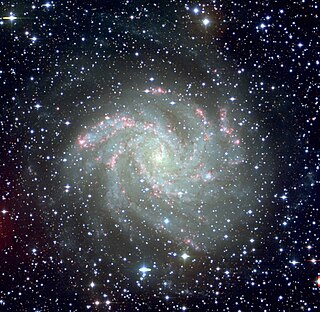
NGC 6946, sometimes referred to as the Fireworks Galaxy, is a face-on intermediate spiral galaxy with a small bright nucleus, whose location in the sky straddles the boundary between the northern constellations of Cepheus and Cygnus. Its distance from Earth is about 25.2 million light-years or 7.72 megaparsecs, similar to the distance of M101 in the constellation Ursa Major. Both were once considered to be part of the Local Group, but are now known to be among the dozen bright spiral galaxies near the Milky Way but beyond the confines of the Local Group. NGC 6946 lies within the Virgo Supercluster.

NGC 4725 is an intermediate barred spiral galaxy with a prominent ring structure, located in the northern constellation of Coma Berenices near the north galactic pole. It was discovered by German-born British astronomer William Herschel on April 6, 1785. The galaxy lies at a distance of approximately 40 megalight-years from the Milky Way. NGC 4725 is the brightest member of the Coma I Group of the Coma-Sculptor Cloud, although it is relatively isolated from the other members of this group. This galaxy is strongly disturbed and is interacting with neighboring spiral galaxy NGC 4747, with its spiral arms showing indications of warping. The pair have an angular separation of 24′, which corresponds to a projected linear separation of 370 kly. A tidal plume extends from NGC 4747 toward NGC 4725.

NGC 6744 is an intermediate spiral galaxy about 30 million light-years away in the constellation Pavo (Peacock). It is considered as a Milky Way mimic in the immediate vicinity, displaying flocculent (fluffy) arms and an elongated core. It also has at least one distorted companion galaxy superficially similar to one of the Magellanic Clouds. It was discovered from Parramatta in Australia by Scottish astronomer James Dunlop on 30 June 1826.
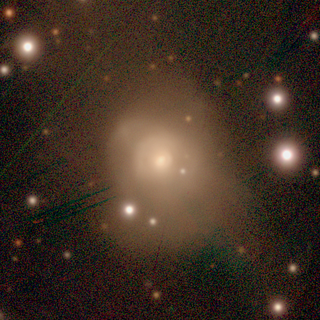
NGC 51 is a lenticular galaxy in the constellation Andromeda. It has a diameter of 90,000 light-years. The galaxy was discovered on September 7, 1885, by Lewis Swift, who described it as "Pretty faint, pretty small, round, brighter middle."

NGC 150 is a barred spiral galaxy in the constellation Sculptor. It is about 70 million light years away from the Solar System, and it has a diameter of about 55,000 light years. It was discovered on 20 November 1886, by Lewis A. Swift. The Type II supernova SN 1990K was detected in NGC 150, and was reported to be similar to SN 1987A.

NGC 165 is a barred spiral galaxy located in the constellation Cetus. It was discovered in 1882 by Wilhelm Tempel and was described by as "faint, large, star in centre, eastern of 2" by John Louis Emil Dreyer.

NGC 180 is a barred spiral galaxy located in the constellation Pisces. It was discovered on December 29, 1790 by William Herschel.

NGC 198 is a spiral galaxy located in the constellation Pisces. It was discovered on December 25, 1790 by William Herschel.
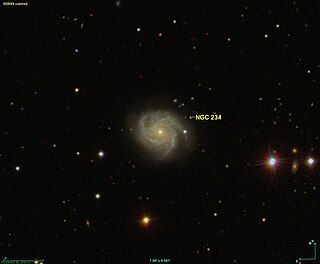
NGC 234 is a spiral galaxy located in the constellation Pisces. It was discovered on October 14, 1784, by William Herschel.
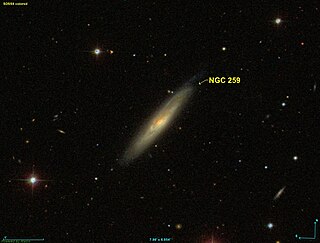
NGC 259 is a spiral galaxy located in the constellation Cetus. It was discovered by William Herschel in 1786.

NGC 298 is a spiral galaxy in the constellation Cetus. It was discovered on September 27, 1864, by Albert Marth. NGC 298 is situated close to the celestial equator and, as such, it is at least partly visible from both hemispheres in certain times of the year. Given its B magnitude of 14.7, NGC 298 is visible with the help of a telescope having an aperture of 20 inches or more.

NGC 304 is a lenticular galaxy in the constellation Andromeda. It was discovered on October 23, 1878, by Édouard Stephan.
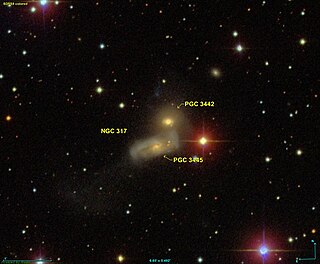
NGC 317 is a pair of interacting galaxies, consisting of a lenticular galaxy NGC 317A and a spiral galaxy NGC 317B, in the constellation Andromeda. It was discovered on October 1, 1885 by Lewis Swift.
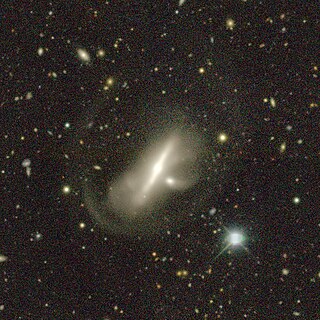
NGC 322 is a lenticular galaxy located approximately 318 million light-years from the Solar System in the constellation Phoenix. It was discovered on September 5, 1834 by John Herschel. It was described by Dreyer as "very faint, very small, round, a little brighter middle, 3 stars to west." It apparently seems to be interacting with PGC 95427, another galaxy.

NGC 327 is a spiral galaxy in the constellation Cetus. It was discovered on September 27, 1864 by Albert Marth. It is described by Dreyer as "faint, small, extended." It is nearby galaxies NGC 329, NGC 325 and NGC 321.

NGC 410 is an elliptical galaxy located in the constellation Pisces. It was discovered on September 12, 1784 by William Herschel. It was described by Dreyer as "pretty bright, pretty large, northeastern of 2.", the other being NGC 407.

NGC 3972 is a spiral galaxy located in the northern constellation of Ursa Major. It was discovered by William Herschel on April 14, 1789. This galaxy is located 66 million light years away and is receding with a heliocentric radial velocity of 846 km/s. It is a member of the NGC 3992 Group of galaxies.
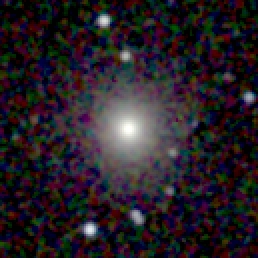
NGC 759 is an elliptical galaxy located 230 million light-years away in the constellation Andromeda. NGC 759 was discovered by astronomer by Heinrich d'Arrest on September 17, 1865. It is a member of Abell 262.

NGC 819 is a spiral galaxy approximately 302 million light-years away from Earth in the constellation of Triangulum. It forms a visual pair with the galaxy NGC 816 5.7' WNW.
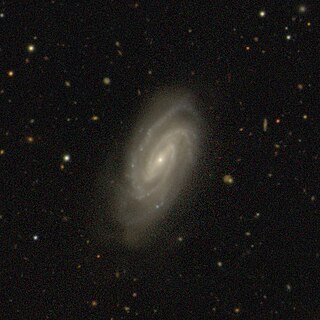
NGC 644 is a barred spiral galaxy in the constellation Phoenix in the southern sky. It is estimated to be 270 million light-years from the Milky Way and has a diameter of approximately 130,000 light-years. Together with NGC 641, it probably forms a gravitationally bound pair of galaxies. The object was discovered on September 5, 1834 by John Herschel.




















